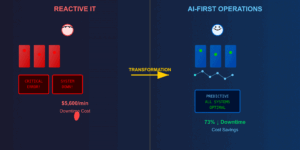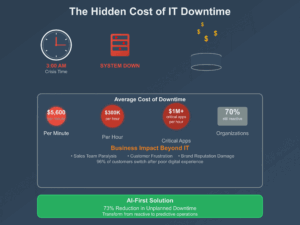
How AI-First IT Operations Are Reshaping Enterprise Technology
Picture this: It’s 3 AM on a Tuesday, and your company’s e-commerce platform crashes during peak traffic from a flash sale. Your IT team scrambles to diagnose the issue while millions in revenue slip away with every passing minute. Sound familiar? This reactive nightmare is playing out in boardrooms worldwide—but it doesn’t have to be your reality.
The era of firefighting IT operations is coming to an end. Welcome to the age of predictive, AI-first IT strategy, where problems are solved before they become problems.

The Hidden Cost of Playing Defense
The numbers don’t lie. According to Gartner, the average cost of IT downtime has reached $5,600 per minute—that’s $300,000 per hour. For large enterprises, a single critical application failure can cost upward of $1 million per hour. Yet 70% of organizations still operate with predominantly reactive IT strategies.
The reactive model isn’t just expensive—it’s strategically dangerous:
Downtime Cascade Effects: When systems fail, the impact ripples through the entire business ecosystem. A server outage doesn’t just affect IT; it paralyzes sales teams, frustrates customers, and can damage brand reputation for years. Research shows that 96% of customers will switch to a competitor after experiencing poor digital performance.
The Innovation Penalty: Teams constantly fighting fires can’t focus on strategic initiatives. IDC research reveals that reactive IT teams spend 70% of their time on maintenance and troubleshooting, leaving only 30% for innovation and growth projects.
Alert Overwhelm: Modern enterprise environments generate an average of 3,000 alerts per day. IT professionals report that 85% of these alerts are false positives or low-priority noise, creating a dangerous environment where critical issues get lost in the chaos.
Talent Drain: The constant pressure of reactive work leads to 40% higher turnover rates in IT departments compared to proactive organizations. The cost of replacing skilled IT professionals’ averages $75,000 per position.

The Predictive Advantage: From Cost Center to Strategic Asset
Forward-thinking organizations are flipping the script. Instead of waiting for problems to surface, they’re using artificial intelligence and machine learning to peek around corners and see issues before they materialize.
Netflix’s Predictive Mastery: Netflix processes over 1 billion hours of content streaming monthly with 99.95% uptime. Their secret? A comprehensive AI-driven monitoring system that predicts and prevents issues before customers ever notice. Their predictive algorithms analyze everything from server performance metrics to user behavior patterns, automatically scaling resources and rerouting traffic before problems occur.
The Business Impact: Organizations implementing AI-first IT operations report:
- 73% reduction in unplanned downtime
- 60% faster incident resolution times
- 45% decrease in operational costs
- 80% improvement in customer satisfaction scores
- 3x faster time-to-market for new digital services
Beyond Monitoring: The Four Pillars of AI-First IT Operations
- Intelligent Data Orchestration
Modern IT environments generate terabytes of operational data daily. AI-first strategies don’t just collect this data—they transform it into actionable intelligence. Machine learning algorithms identify patterns across disparate systems, correlating seemingly unrelated events to predict complex failure scenarios.
- Autonomous Issue Resolution
The most advanced AI-first operations go beyond prediction to autonomous remediation. When algorithms detect early warning signs of disk space issues, network congestion, or application performance degradation, they automatically trigger corrective actions without human intervention.
- Contextual Security Intelligence
Traditional security tools react to breaches after they occur. AI-first security uses behavioral analytics to identify anomalies that indicate potential threats. By analyzing normal patterns of user behavior, network traffic, and system access, AI can flag suspicious activities long before they escalate into security incidents.
- Continuous Performance Optimization
Rather than manually tuning systems based on historical performance, AI-first operations continuously optimize resource allocation in real-time. This dynamic approach ensures peak performance while minimizing costs through intelligent resource scaling and workload distribution.
Your Roadmap to AI-First Transformation
Phase 1: Foundation Building (Months 1-3)
Data Infrastructure Assessment: Audit your current monitoring capabilities and data quality. AI models are only as good as the data they consume. Identify gaps in coverage and establish baseline metrics for your transformation.
Quick Win Identification: Target high-impact, low-complexity use cases for your initial AI implementation. Common starting points include capacity planning for storage systems or predicting routine maintenance windows.
Phase 2: Pilot Implementation (Months 4-6)
Strategic Pilot Selection: Choose a critical but contained system for your first predictive implementation. Ideal candidates are systems with:
- Rich historical data
- Clear success metrics
- High business impact when they fail
- Supportive stakeholders
Cross-Functional Team Assembly: Success requires collaboration between IT operations, data scientists, and business stakeholders. Create a dedicated team with clear accountability for pilot success.





